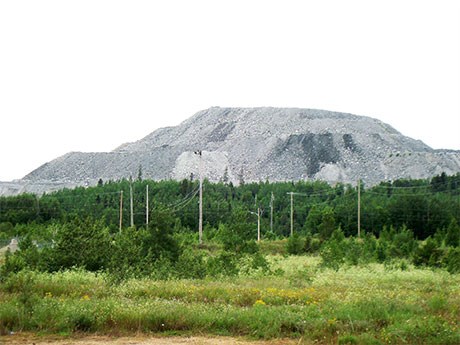Forestry waste put to good use
Adding a vegetative cover to one of the largest rock piles in Canada outside the Alberta tar sands is no small challenge. The rock pile in question sits beside a Barrick Gold open pit mine in Hemlo, 350 kilometres east of
Thunder Bay.
With the depletion of ore on the horizon and the need to begin thinking about restoring the property to some semblance of its original state when the mine closes in 2020, Barrick Gold reached out to Laurentian University professors Graeme Spiers and Peter Beckett to explore the possibility of using manufactured soil.
Spiers and Beckett, in turn, turned the challenge over to graduate student Autumn Watkinson, who shared some of her findings in a presentation at the Mining and Environment International Conference in Sudbury June 23rd.
A manufactured product made a lot of sense given the unavailability of topsoil within the region and the deleterious environmental impacts of acquiring material from a distance.
Forest waste
Rather than incur the cost of purchasing and transporting topsoil and remediating one ecosystem at the expense of another, Watkinson experimented with waste material from two nearby forest product operations together with finely crushed mine rock to create a manufactured product.
A lumber mill in White River, 60 kilometres east of Hemlo, “had a huge pile of woody residuals consisting of sawdust, bark and wood chips just sitting there waiting for someone to do something with it,” said Watkinson.
Approximately 100 kilometres to the west, the Terrace Bay pulp mill produced a sludge material, “so the thinking was that we could use these constituents to manufacture a viable soil for reclamation of the site.’
Everyone wins, provided it works. Barrick gets a manufactured soil to remediate its rock pile and the forest product companies get rid of a waste product they might otherwise have to dispose of in landfills. Waste from one industry is used to remediate the environmental impacts of another industry.
In addition, “if you’re manufacturing a soil, we can tailor it to a specific purpose or function that we want it to achieve,” said Watkinson.
The research began with a 10-week growth study in Sudbury using the proposed soil constituents with different ratios of organics.
“We found that after 10 weeks of growth, the manufactured soils containing the woody residuals produced a significantly higher amount of above ground biomass than the soils that contained paper sludge,” said Watkinson. “We also found that increasing the amount of woody residuals in the soil effectively decreased the root to shoot ratios of the plants. That just means the plants were happier. They were getting the nutrients and the water they needed to produce a good amount of above ground biomass without having to put extra energy into root production.”
The next step was to test the combination of woody residuals and finely crushed mine rock in a series of plots at the mine site. Two mixtures were tested – one containing 40 per cent organics, the other 80 per cent – at depths of 30 and 60 centimetres.
Sensors
Sensors were installed in the plots to measure the moisture retention capabilities of the manufactured soil at different levels.
The results indicated that the manufactured soil containing 80 per cent organics at a depth of 30 centimetres performed best in retaining moisture in the critical zone close to surface and was ideal for establishing plants from seed. Plots with a 60-centimetre depth of manufactured soil, on the other hand, had poor moisture retention close to surface but a good reservoir of moisture at greater depth, making it ideal for more mature vegetation.
Concocting a recipe that provides a good growth medium for the full life cycle of the vegetative cover could involve the addition of other moisture-retaining material close to surface, said Watkinson.
Representatives from Hemlo will be meeting with government regulators later this year to determine whether the manufactured soil can be included as part of the mine’s eventual closure plan and remediation strategy.
“We’re always looking to improve our environmental performance, and this is one of the many ways we’re looking at to enhance closure at the site,” said Andrew Baumen, general manager of Barrick’s Hemlo operation.



